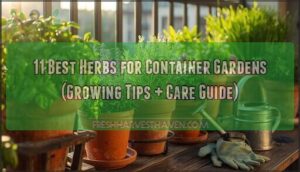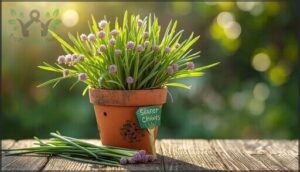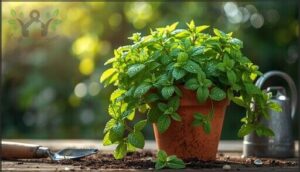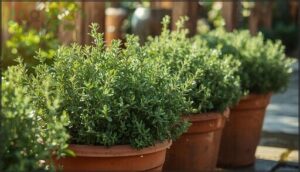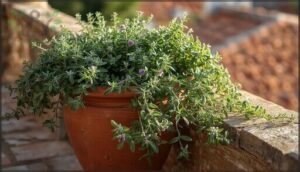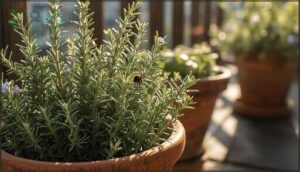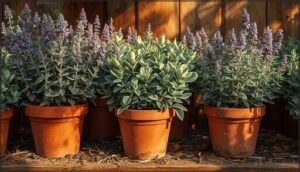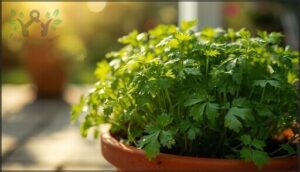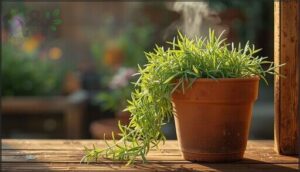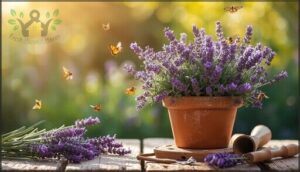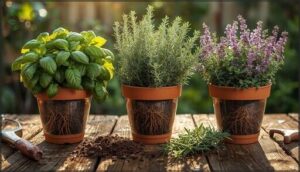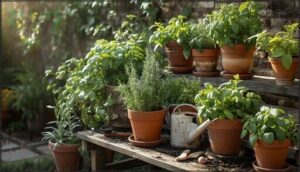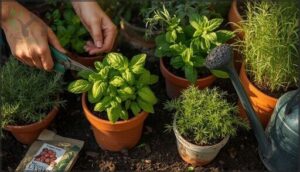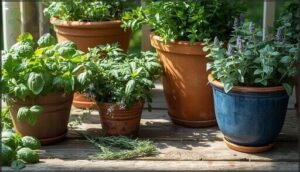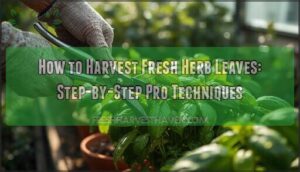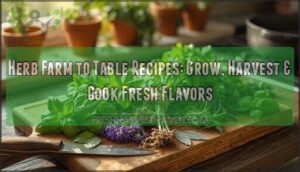This site is supported by our readers. We may earn a commission, at no cost to you, if you purchase through links.
You don’t need a sprawling backyard to grow a thriving herb garden—just a few well-chosen containers and the right plants. Container gardening opens up fresh possibilities for apartment dwellers, renters, and anyone working with limited outdoor space, letting you cultivate fragrant, flavorful herbs right on your patio, balcony, or kitchen windowsill.
The secret lies in selecting herbs that actually enjoy the cozy confines of a pot, where their roots can spread comfortably without becoming aggressive invaders. Some herbs adapt beautifully to container life, producing abundant harvests with minimal fuss, while others struggle or quickly outgrow their homes.
Once you know which herbs thrive in pots and understand their basic needs, you’ll be snipping fresh basil for pasta, garnishing dishes with chives, and brewing mint tea from your own mini garden in no time.
Table Of Contents
- Key Takeaways
- Top Herbs for Container Gardening
- Basil – The Classic Container Herb
- Chives – Easy and Productive
- Parsley – Continuous Harvests
- Mint – Contained and Vigorous
- Thyme – Low-Maintenance Favorite
- Oregano – Mediterranean Essential
- Rosemary – Fragrant and Hardy
- Sage – Resilient and Versatile
- Cilantro – Fast-Growing Annual
- Tarragon – Unique Flavor Addition
- Lavender – Aromatic and Attractive
- Key Characteristics of Successful Container Herbs
- Essential Container Garden Setup Tips
- Herb Care and Maintenance in Containers
- Designing and Pairing Herbs in Containers
- Frequently Asked Questions (FAQs)
- What herbs are good for container gardens?
- What herbs go well together in a container?
- What herbs grow best together in pots?
- What herbs not to plant together in pots?
- What are the best herbs for container gardening?
- How many herbs can I plant in a 5 gallon bucket?
- How to protect herbs from extreme temperatures?
- What pests commonly affect container-grown herbs?
- Can companion planting benefit container herb gardens?
- Which herbs thrive indoors with limited sunlight?
- Conclusion
Key Takeaways
- Container gardening works brilliantly for herbs like basil, chives, parsley, mint, and thyme because these plants adapt naturally to confined spaces with shallow root systems and non-invasive growth habits that won’t overtake your pots.
- Success hinges on three non-negotiables: containers with drainage holes (to prevent root rot), well-draining potting mix with perlite (never garden soil), and at least six hours of direct sunlight daily for most herbs.
- Strategic companion planting amplifies your harvest—pairing Mediterranean herbs like rosemary, thyme, and oregano together works perfectly since they share similar water and sun needs, while aggressive spreaders like mint and fennel must stay isolated.
- Regular maintenance through weekly harvesting, proper pruning above leaf nodes, and consistent watering (containers dry 30-50% faster than garden beds) keeps your herbs productive and prevents the leggy, weak growth that comes from neglect.
Top Herbs for Container Gardening
You’ve got plenty of herbs to choose from when building a container garden, but not all of them are created equal. Some thrive in pots with minimal fuss, while others need more attention or space than containers can offer.
Here are eleven herbs that’ll flourish in your containers, whether you’re growing on a sunny balcony or a kitchen windowsill.
Basil – The Classic Container Herb
Basil stands as the crown jewel of container gardens, thriving in pots with at least 6 to 8 inches of soil space. You’ll want to choose productive basil varieties like Genovese or Sweet, ensuring they receive six hours of direct sunlight daily.
Keep the soil consistently moist—watering early prevents fungal issues. To promote healthy growth, basil requires full sun exposure.
Harvest every 7 to 10 days once plants reach 6 inches tall, pinching shoot tips to encourage bushier growth and delay flowering.
Chives – Easy and Productive
If you’re looking for a truly low-fuss option, chives deliver on every front. These perennial clumpers need just 6 to 8 inches of pot depth and reward you with continuous harvests all season long—just snip and they’ll bounce back. Their fibrous roots stay compact, making them perfect for container gardens.
Chive propagation through division every few years keeps them productive. Those purple blooms? They’re edible and wonderful for companion planting, attracting pollinators while adding mild onion flavor to your culinary uses year-round, even with simple winter care indoors.
Using containers with essential bottom holes is vital for proper drainage.
Parsley – Continuous Harvests
Parsley stands out in container gardens thanks to impressive regrowth factors. Harvest every 7 to 14 days once your plant has 5 to 10 stems. Proper harvesting techniques matter: cut outer stems 1 to 1.25 inches above the crown to keep those central buds producing.
Yield optimization depends on soil requirements like consistent moisture and balanced fertilizer, plus understanding seasonal impact—year one brings vigorous growth, while year two slows as flowering begins.
Mint – Contained and Vigorous
You’ll love mint in container gardens—it’s vigorous but noninvasive when properly contained. Aim for a 12 to 14-inch pot (terracotta works great for moisture control) with 6 to 8 inches of soil depth.
Mint’s environmental adaptability shines in sun or shade, and you’ll get impressive yield optimization: up to 1 pound per 4 square feet after six months. Just keep containers spaced three feet apart to preserve each variety’s unique flavor.
Thyme – Low-Maintenance Favorite
With shallow roots perfect for growing herbs in containers, thyme varieties thrive in 6-inch pots with minimal fuss. You’ll need well-draining soil and 6 to 8 hours of sun—then just water when the top inch dries out.
This drought-tolerant powerhouse shows impressive pest resistance and delivers three years of culinary uses in your container herb gardening setup, making thyme care refreshingly simple.
Oregano – Mediterranean Essential
This Mediterranean powerhouse thrives in container gardens, delivering impressive oil yield and bioactive content when you give it a 12-inch pot with excellent drainage. Oregano’s natural pest resistance makes growing herbs in containers wonderfully low-fuss—just provide 6+ hours of sun and let the soil dry between waterings.
With market growth reflecting its culinary value, you’re cultivating both flavor and wellness in one hardy herb.
Rosemary – Fragrant and Hardy
Rosemary brings unbeatable drought tolerance and pest resistance to container gardens, thriving in 12-inch pots with minimal fuss. This fragrant powerhouse produces essential oil-rich foliage while attracting pollinators to your space—even balconies!
Container performance stays strong with 6+ hours of sun and well-draining soil. Growing herbs in containers doesn’t get easier than rosemary’s hardy nature and year-round herb characteristics that improve your cooking instantly.
Sage – Resilient and Versatile
Sage brings unparalleled resilience to container gardens, thriving year after year with minimal fuss. This perennial powerhouse naturally repels flea beetles and carrot flies while delivering nutrient-packed leaves for your kitchen.
Growing herbs in containers works beautifully with sage when you provide:
- Pots 8–10 inches deep for healthy roots
- Six hours of direct sunlight daily
- Well-draining soil to prevent mildew
Different sage varieties share these winning herb characteristics!
Cilantro – Fast-Growing Annual
Cilantro delivers lightning-fast results for container gardening enthusiasts—you’ll harvest fresh leaves in just 50 to 80 days! This annual herb thrives in 10–12 inch deep pots with well-draining soil and afternoon shade in hot climates.
Growing herbs in containers works brilliantly with cilantro when you practice successive sowing every 2-3 weeks. Smart harvesting methods and bolting prevention through cooler temperatures reveal impressive regrowth potential for continuous herb care success.
Tarragon – Unique Flavor Addition
French tarragon brings an elegant anise-like flavor to your container gardening lineup—perfect for culinary herbs! This perennial needs at least an 8-inch wide pot with well-draining soil (try a 2:1:1 mix of garden soil, sand, and compost).
- Choose French over Russian tarragon varieties for better flavor profiles
- Water deeply every 3-5 days, checking soil moisture to prevent root rot
- Enjoy strong disease resistance thanks to natural pest-repelling oils
Your herb flavor profiles peak in year one!
Lavender – Aromatic and Attractive
Looking for aromatic herbs that double as pollinator magnets? Lavender varieties like compact ‘Hidcote’ thrive in 12–16 inch containers with excellent drainage—think unglazed terra cotta!
Your container gardening success hinges on 6–8 hours of direct sunlight daily, promoting those fragrant purple spikes that attract beneficial insects like bees and butterflies.
Bonus: lavender’s natural pest resistance and minimal herb care requirements make growing herbs in containers practically foolproof!
Key Characteristics of Successful Container Herbs
Not all herbs are created equal when it comes to thriving in pots. You’ll want to choose varieties that play nicely within their container boundaries and won’t stage a hostile takeover of your garden space.
Let’s look at the key traits that make certain herbs perfect candidates for container life.
Non-Invasive Growth Habits
When growing herbs in containers, you want noninvasive herb varieties that respect their space. Thyme, chives, and parsley keep their roots confined—usually within 12-15 cm—making them perfect for companion planting.
These herb growth habits mean no wrestling with aggressive spreaders. Proper pot size and root containment naturally support spreading control, while seasonal patterns stay predictable. Herbs that thrive in containers simply know their boundaries.
Compact and Clumping Varieties
Compact herb varieties deliver serious space efficiency—an 18-inch pot fits 2–3 plants without triggering root competition. Dwarf basil varieties stay under 10 inches tall, while thyme mats out at 12 inches wide, perfect for container garden design. These clumping growth patterns boost yield statistics too: parsley harvests 15 times yearly, producing over 20 ounces per plant. Plus, proper spacing cuts disease resistance issues by 25%.
Why compact varieties excel in containers:
- Clumping herbs occupy 30% less surface area than sprawling types, maximizing your growing space
- Root systems stay under 6 inches in diameter, preventing pot-bound stress in standard containers
- Disease resistance improves noticeably—powdery mildew drops 25% compared to trailing herb varieties
- Chives generate 6–8 harvestable clumps annually, each cutting averaging 1 ounce of fresh greens
- Container-specific cultivars remain under 12 inches at maturity, ideal for high-density arrangements
Herbs With Shallow Root Systems
Beyond clumping habits, shallow root systems make certain herb varieties incredibly container-friendly. Chives max out at three inches deep, while oregano and thyme hit six inches—perfect for smaller pots with limited soil depth.
This shallow architecture impacts your watering frequency though: limited soil moisture retention means you’ll water more often. Well-draining potting mix becomes non-negotiable to prevent nutrient leaching and root rot in these compact root zones.
Attracting Beneficial Insects
You’re not just growing flavor when herbs bloom—you’re building an ecosystem. Yarrow attracts the widest predator insect diversity, while dill and parsley draw ladybugs and lacewings early in the season.
Strategic container gardening with basil and mint can slash aphid infestations by 70%.
Strategic container gardening with basil and mint can slash aphid infestations by 70%
Design for insect attraction by staggering bloom times, and you’ll see pollinator population impact soar with nectar pollen provisioning throughout summer.
Essential Container Garden Setup Tips
Setting up your container herb garden the right way makes all the difference between thriving plants and disappointing results. You don’t need fancy equipment or a green thumb, just a few key decisions about containers, soil, and placement.
Let’s walk through the essential setup steps that’ll give your herbs the best shot at success.
Choosing The Right Container Size
Think of container size as your herb’s home—too cramped, and it’ll struggle. For most herbs, a 6- to 8-inch deep pot works beautifully, but taprooted varieties like parsley need at least 12 inches.
Container dimensions directly affect root system development, water retention, and growth impact. A 12-inch pot holds about 3.5 gallons and accommodates 3–4 plants comfortably, maximizing your container gardening success.
Ensuring Proper Drainage and Aeration
Without at least one drainage hole, your herbs face a 90% higher risk of root rot. Containers lacking proper drainage create waterlogged soil conditions that choke roots and invite fungal diseases—up to 75% more often.
Choose porous materials like terracotta for better soil aeration, and guarantee well-drained soil by spacing holes every 3–4 inches across larger pots for best drainage.
Selecting Well-Draining Potting Mix
Your potting mix makes or breaks your herb’s health. Skip garden soil—it compacts and suffocates roots. Instead, choose a well-drained potting mix with 10–30% perlite for enhanced drainage properties and water retention.
Most herb soil requirements call for a pH balance between 6.0 and 7.0. Mix ratios matter: try equal parts soilless mix and compost.
Organic vs. synthetic? Both work, but organic options boost natural disease resistance.
Providing Adequate Sunlight
Sunlight exposure is your herb garden’s power source—most herbs crave at least 6 hours of full sun daily to enable vigorous growth and intense flavors. Without sufficient sun hours, you’ll see thinner stems and weaker aromas.
South-facing spots deliver the best light intensity outdoors, while indoor growers should consider artificial lighting or seasonal adjustments to meet herb light requirements year-round.
Herb Care and Maintenance in Containers
Once your herbs are settled into their containers, the real work begins—but it’s easier than you might think. Proper watering, feeding, and pruning will keep your plants healthy and productive throughout the growing season.
Let’s break down the essential care practices that’ll help your container herbs thrive.
Watering and Humidity Needs
Herbs in pots drink more than you’d think—soil dries out 30–50% faster than garden beds, so regular watering becomes your daily rhythm. Check moisture levels by testing the top inch; when it’s dry, water deeply until it drains through.
Here’s your watering playbook:
- Small containers need attention twice daily in summer heat
- Indoor herbs thrive with weekly watering, adjusted for humidity levels
- Drip systems cut water waste by 60% while maintaining consistent soil moisture
- Group pots together to boost humidity by 5–15%, reducing herb watering needs
Fertilization Practices
Once you’ve nailed watering, feeding becomes your next superpower. Container herbs need regular nutrition since potting mix lacks the organic matter found in garden soil. Organic fertilizers release nutrients gradually, building microbial life, while synthetics deliver quick boosts—each has its place in your herb-growing tips toolkit.
Here’s your fertilization game plan:
| Fertilizer Type | Dosage Frequency | Best For |
|---|---|---|
| Slow-release organic | Every 4–5 weeks | Basil, sage, parsley |
| Liquid (100 ppm N) | Weekly at half-strength | Fast growers, cilantro |
| Compost blend (20–50%) | Mixed at planting | Improved water retention |
| Water-soluble boost | Biweekly during growth | Peak production periods |
| Turkey litter-based | Monthly supplement | Long-term container health |
Watch for nutrient deficiency—pale leaves and weak stems signal it’s feeding time. Lower doses actually improve flavor in herbs versus high-nitrogen synthetic outcomes that prioritize leaf volume over taste. Timing practices matter: fertilize during active growth, pair with proper drainage in your well-drained potting mix, and ease off as plants mature to avoid leggy growth.
Pruning and Harvesting Techniques
With feeding sorted, smart pruning becomes your secret weapon for explosive growth. You can safely trim up to 75% of current-season stems—boosting lateral shoots by 60% in basil. Harvest yields jump when you clip one-third weekly, and regrowth rates peak at 14 days with proper timing.
Essential herb maintenance moves:
- Cut above leaf nodes on soft herbs, promoting bushier regrowth and extended harvests
- Sterilize tools between plants—reducing disease transmission by 70% through proper sanitation
- Prune every 1–2 weeks during summer for annuals like basil and cilantro
- Harvest before flowering to maintain peak flavor concentration and leaf production
- Trim woody herbs by half in early spring, preventing dieback while maximizing yields
Pest and Disease Prevention
Clean tools won’t save you if pests hitchhike in. Isolate new plants for two weeks—screening catches tiny stowaways before they spread.
Natural repellents like basil and mint interfere with pest scent trails, while smart watering practices at the base slash fungal problems by 45%.
Monitor with sticky traps, keep disease-resistant varieties, and attract beneficial insects to handle herb pest control without chemicals.
Designing and Pairing Herbs in Containers
Creating a thriving container herb garden isn’t just about picking the right plants—it’s about pairing them thoughtfully so they grow strong together. Some herbs make perfect neighbors, sharing similar needs and even boosting each other’s flavor, while others compete for resources or send out roots that crowd their pot-mates.
Let’s explore how to design smart combinations, avoid common pairing mistakes, and arrange your containers for maximum beauty and productivity.
Best Herb Combinations for Pots
Pairing companion plants by culinary synergy and soil compatibility sets your container garden herb selection up for success. You’ll want basil, oregano, and thyme together—their aromatic pairings naturally improve pest control while herbs that thrive in containers share moisture needs. Rosemary, sage, and chives create another winning trio.
Match growth habits carefully; mint’s aggressive nature demands solo planting. Smart companion herb planting in your container garden design maximizes both flavor and plant health.
Herbs to Avoid Planting Together
Avoid planting fennel near cilantro—allelopathic effects from fennel’s compounds will stunt your cilantro’s growth. Similarly, wormwood releases toxicity risks that harm sage and caraway.
You’ll face growth competition when pairing mint with other companion plants; its aggressive spread demands isolation in your herb garden design.
Watch for water conflicts too—wormwood’s dry preferences clash with moisture-loving fennel, creating pest attraction issues that compromise your companion herb planting success.
Companion Planting for Growth and Flavor
When you plant basil alongside rosemary, you’re not just saving space—you’re boosting flavor profiles and creating natural pest repellents. Companion herb planting increases yields by up to 32% while attracting pollinators that improve your herb garden’s productivity.
Pair shallow-rooted chives with deep-rooted herbs to maximize soil health and nutrients. These companion plants work together, improving culinary uses of herbs through improved flavor enrichment and biological pest control.
Arranging Containers for Indoor and Outdoor Spaces
For indoor herb gardens, place potted herbs near south-facing windows where sunlight optimization reaches 6-8 hours daily. Outdoor herb gardens benefit from seasonal movement—roll your container garden to sunny spots throughout the day.
Space considerations matter: arrange taller herbs behind shorter ones for aesthetic appeal. Create microclimates by grouping moisture-lovers together, and position drought-tolerant varieties where growing herbs in containers drain faster.
Frequently Asked Questions (FAQs)
What herbs are good for container gardens?
You’d think herbs are picky divas demanding sprawling estates, but the truth? Most laugh in the face of garden beds and absolutely thrive in pots.
Basil, mint, thyme, rosemary, and parsley are beginner herbs with delightful flavor profiles and aromatic benefits that flourish as potted herbs, making growing herbs in containers ridiculously rewarding for culinary uses.
What herbs go well together in a container?
Mediterranean herbs like rosemary, thyme, oregano, and sage make perfect container companions, sharing similar sunlight and water needs. Basil pairs beautifully with parsley and cilantro.
Companion planting with growth compatibility ensures your themed gardens thrive together effortlessly.
What herbs grow best together in pots?
Companion planting thrives when you match herbs with similar water and sun needs. Basil and oregano flourish together in Mediterranean-themed pots, while sage and chives make excellent partners. Smart pairings minimize root competition and boost harvest yields naturally.
What herbs not to plant together in pots?
Avoid pairing rue with basil or sage due to chemical incompatibilities. Keep fennel isolated—it stunts neighbors.
Don’t mix moisture-loving mint with drought-tolerant Mediterranean herbs like thyme, creating water conflicts and space competition issues.
What are the best herbs for container gardening?
Picture a sunny apartment balcony transformed into a fragrant kitchen garden—that’s container gardening magic.
The best herbs for pots include basil, thyme, chives, and rosemary, chosen for their compact growth habits and beginner friendliness.
How many herbs can I plant in a 5 gallon bucket?
You can plant three to four small herbs like basil or parsley in a 5-gallon bucket, but limit woody herbs like rosemary to just one plant to guarantee proper root space and healthy yields.
How to protect herbs from extreme temperatures?
Mulch root insulation and shading techniques protect potted herbs during heatwaves. Understanding herb sensitivities guides irrigation management—water early mornings and evenings.
Creative protection like frost jackets, water walls, and relocating your container garden indoors shields herbs from extreme cold effectively.
What pests commonly affect container-grown herbs?
Your potted herbs face threats like aphids, whiteflies, spider mites, fungus gnats, and caterpillars. Proper herb pest control keeps your container garden thriving.
Caring for herbs means watching for webbing, yellowing leaves, and soil-dwelling larvae regularly.
Can companion planting benefit container herb gardens?
Yes—pairing herbs isn’t just neighborly, it’s strategic! Companion planting boosts pest reduction, yield improvement, and pollination in container gardens.
Think space efficiency, disease suppression, and beneficial insects working overtime for healthier, more productive herb garden care.
Which herbs thrive indoors with limited sunlight?
Mint, parsley, chives, lemon balm, and cilantro excel in indoor gardening with limited sun, thriving in filtered light.
These potted herbs require consistent moisture, sparse fertilization, and indoor pest control while adapting beautifully to shade herb pruning practices.
Conclusion
Studies show that just 15 minutes of daily gardening can greatly reduce stress levels—and snipping fresh herbs from your own containers doubles that benefit.
Now that you know the best herbs for container gardens and how to care for them, you can transform even the smallest space into a productive, aromatic retreat.
Start with two or three favorites, master their rhythms, and watch your confidence—and your harvests—grow abundantly season after season.
- https://www.bhg.com/gardening/vegetable/herbs/best-herbs-for-container-gardens/
- https://www.finegardening.com/article/six-superb-herbs-for-containers
- https://www.gardeningknowhow.com/edible/herbs/hgen/herb-plants-growing-in-one-pot.htm
- https://cultivatedearth.com/en/herbs/parsley-regrowth/
- https://www.academia.edu/3205469/Economic_Evaluations_for_Harvesting_Mangment_of_Parsley_Petroselinium_Sativum_Crispum_Mill_Nym_and_Dill_Anithum_Graveolens_L_Plants_Under_North_Sinai_Conditions

